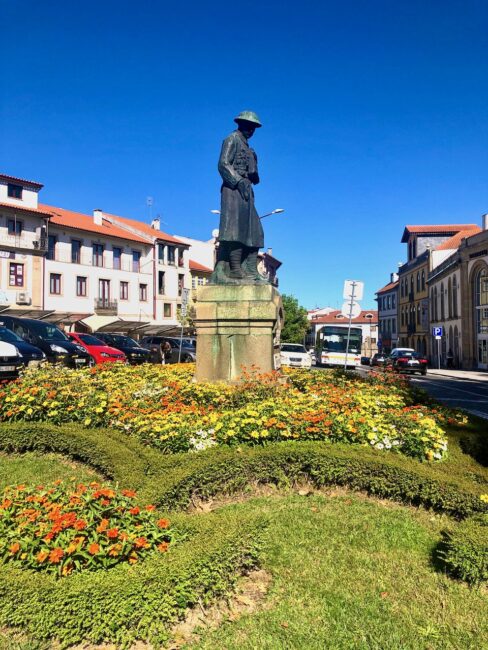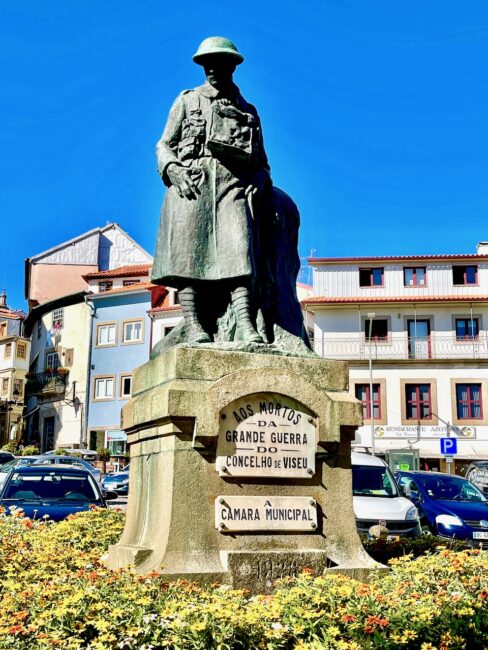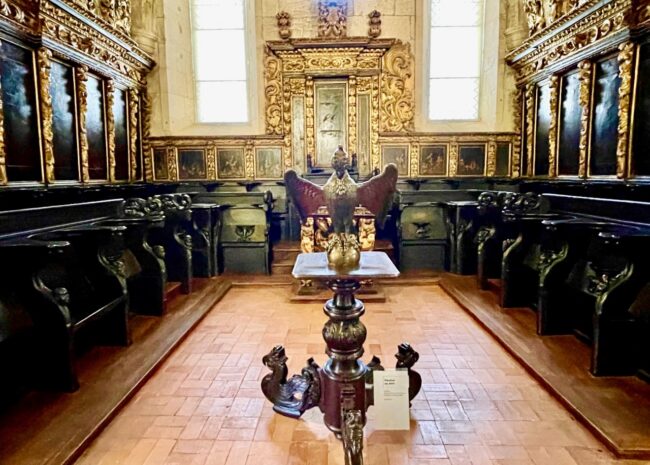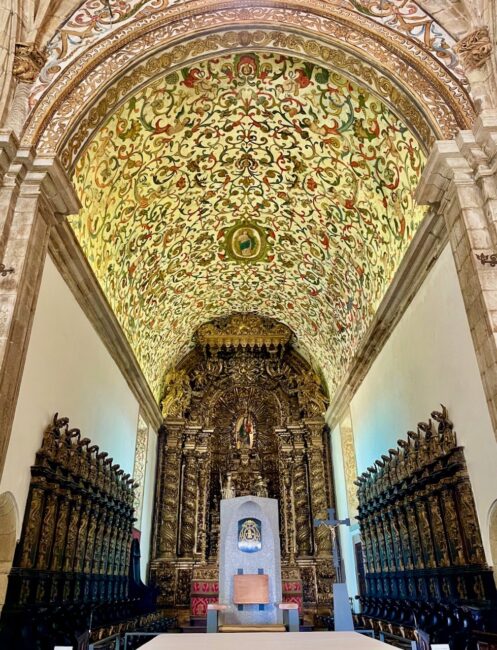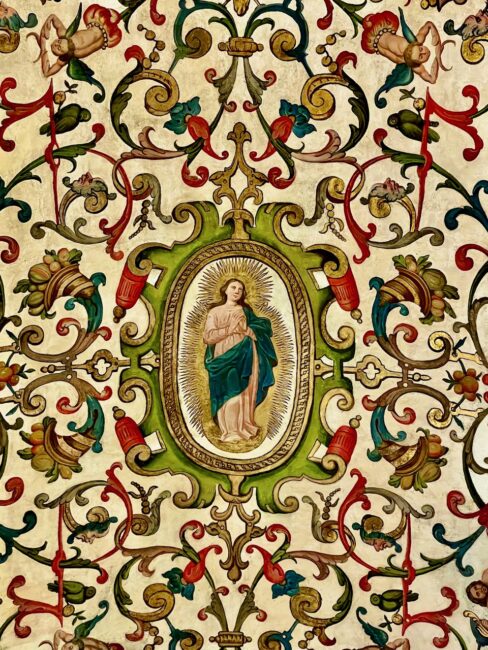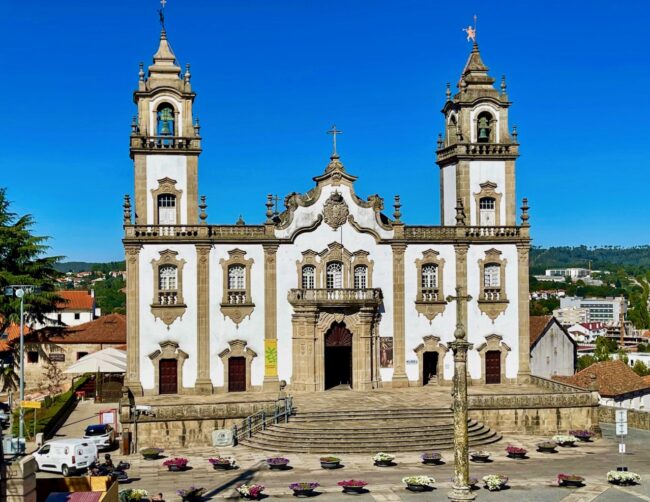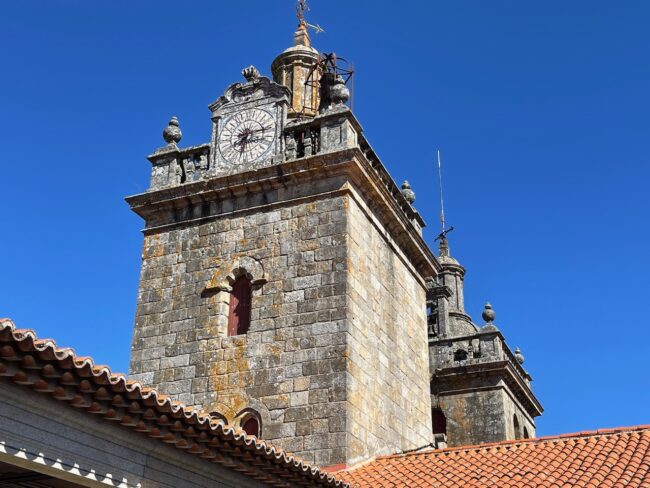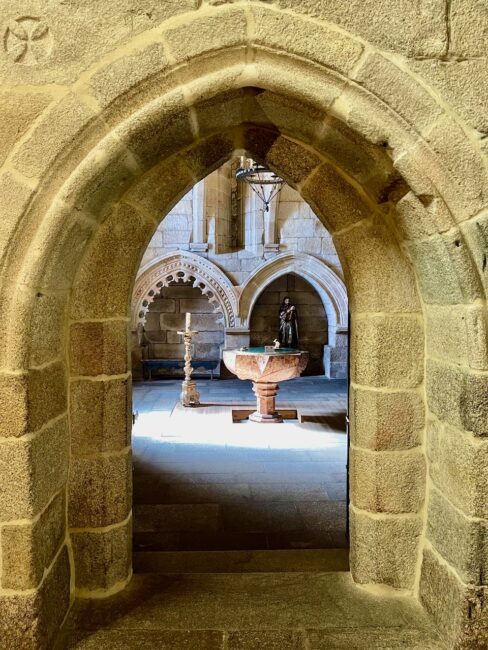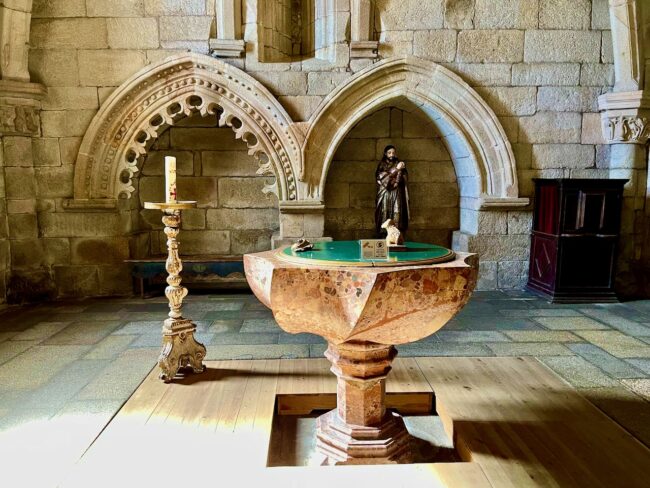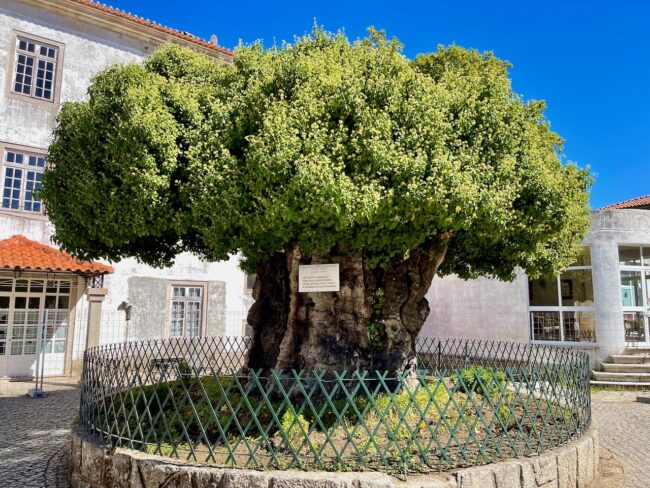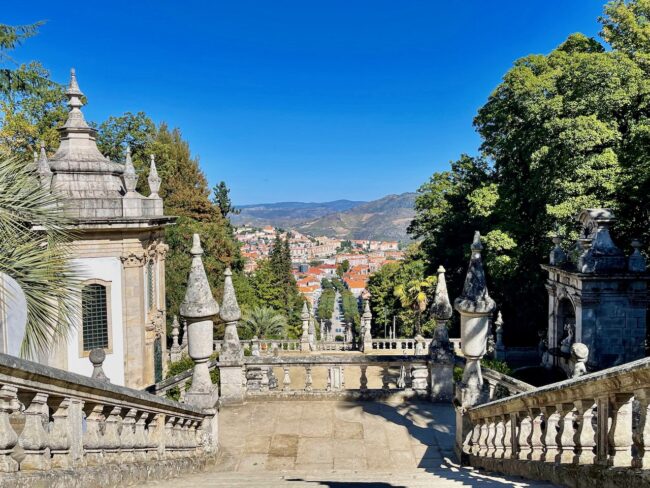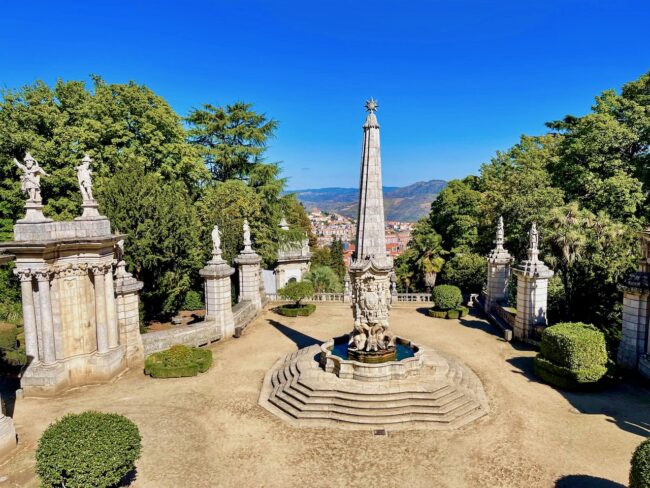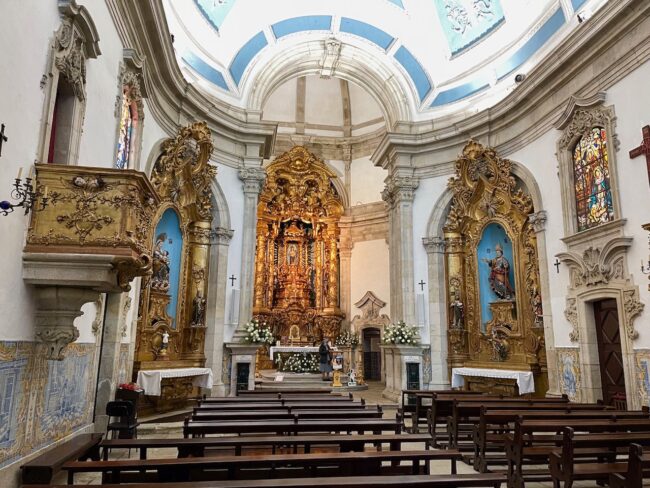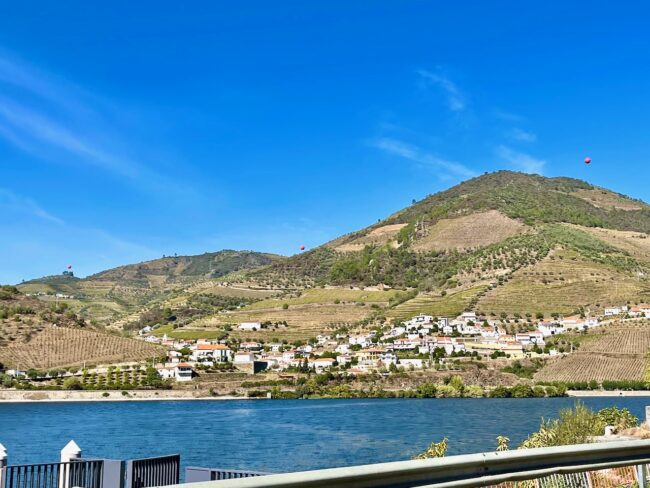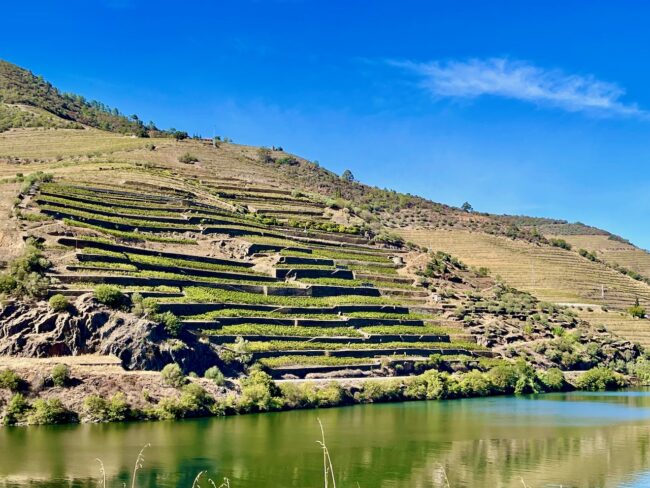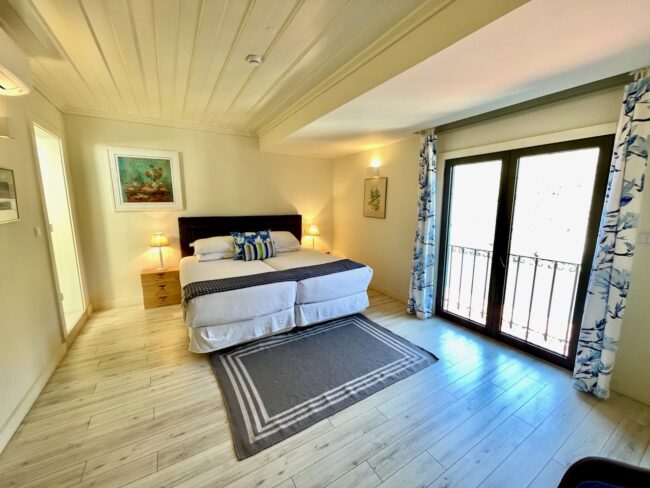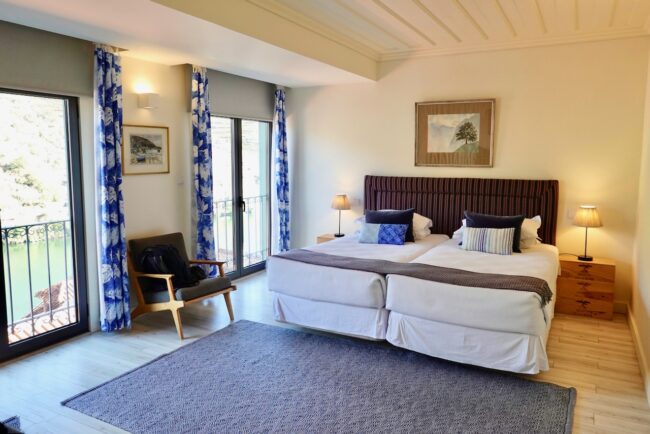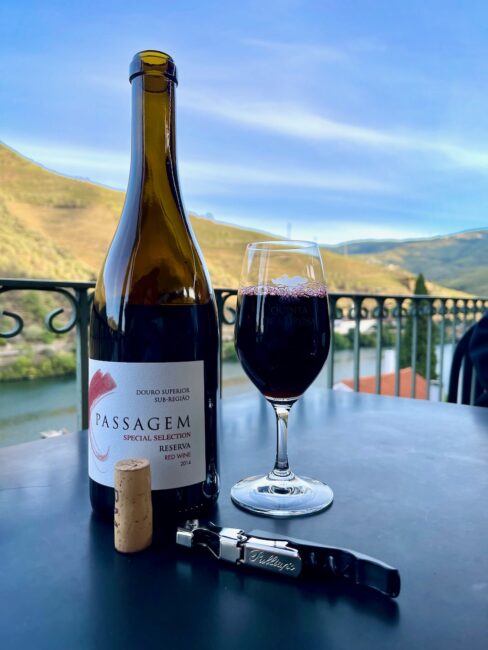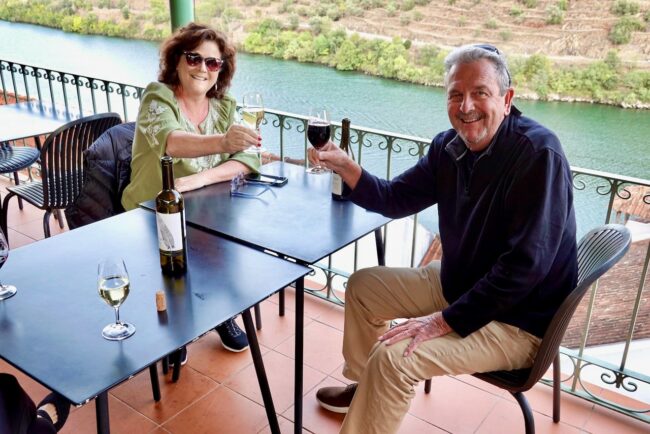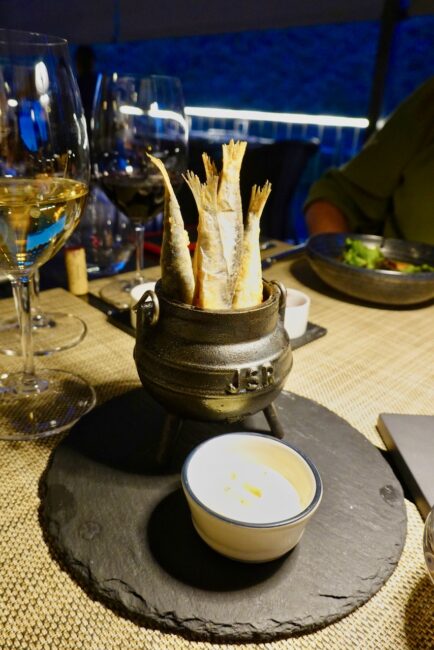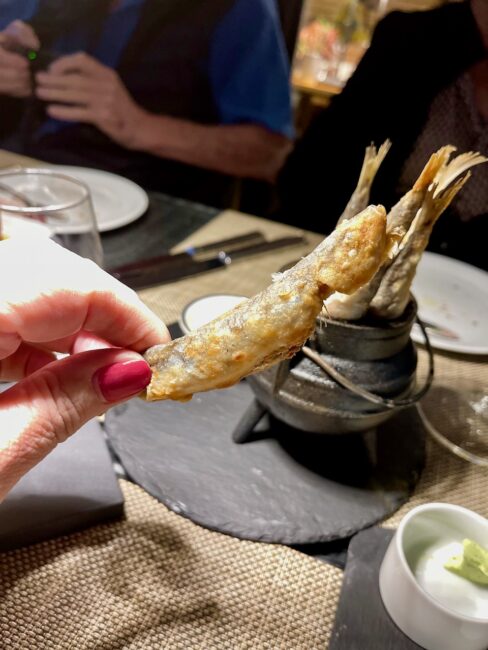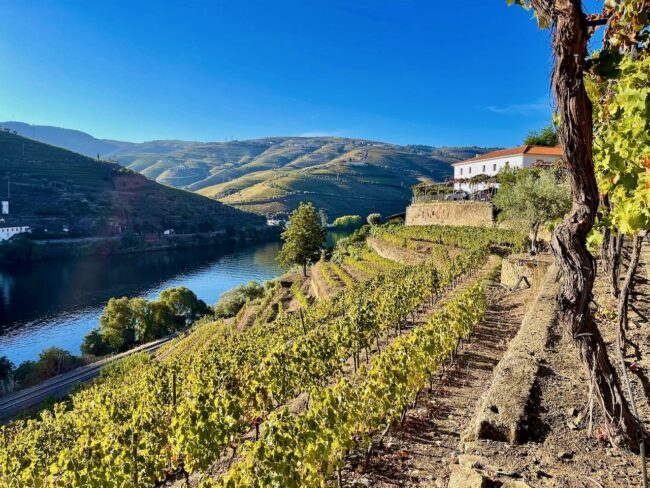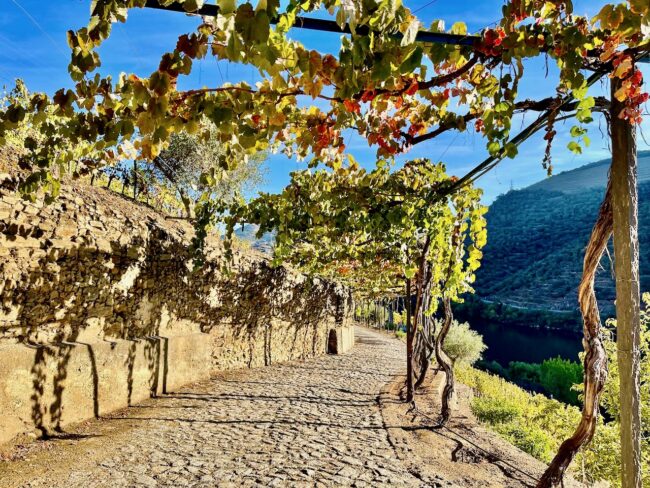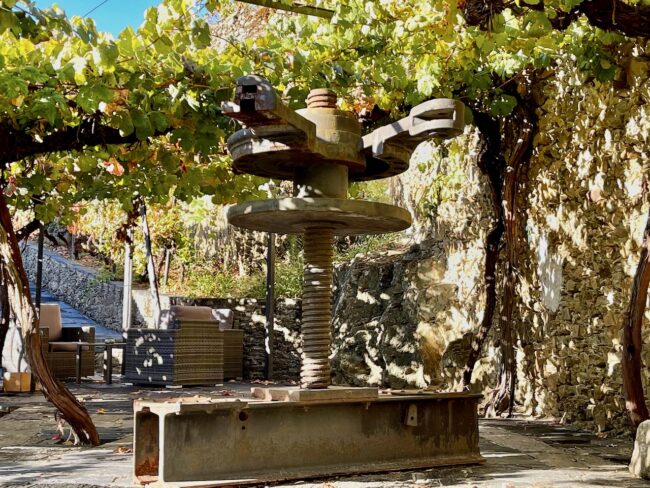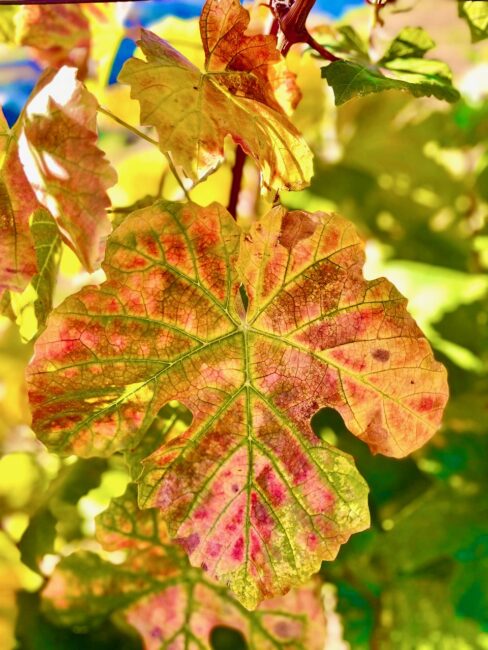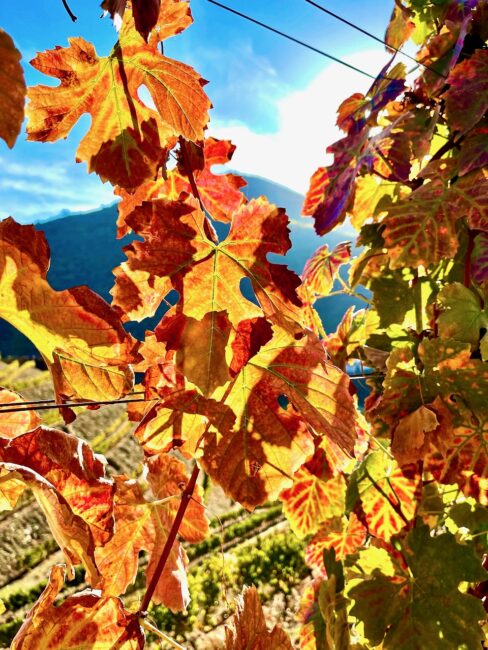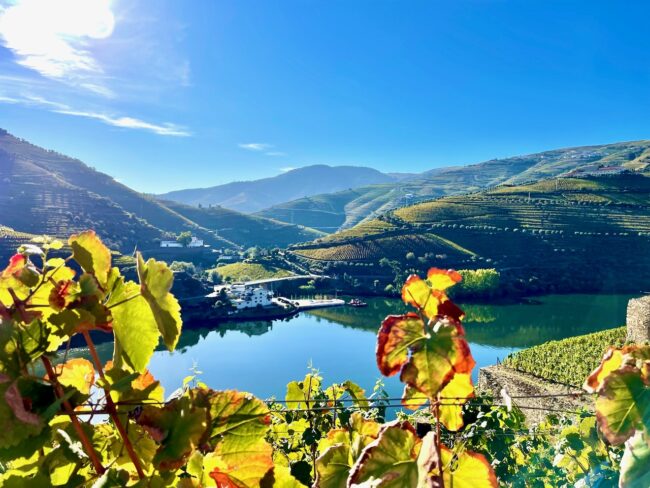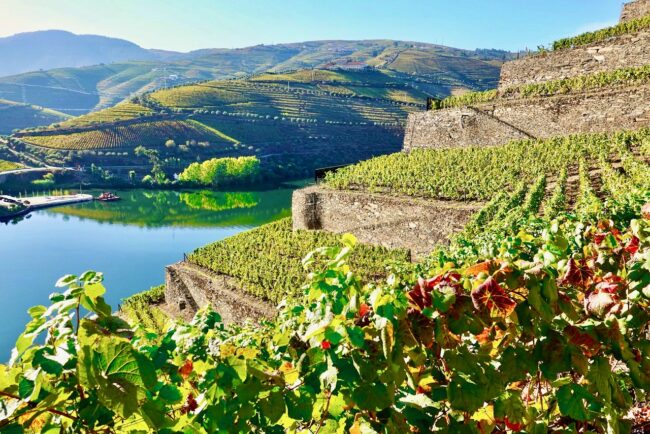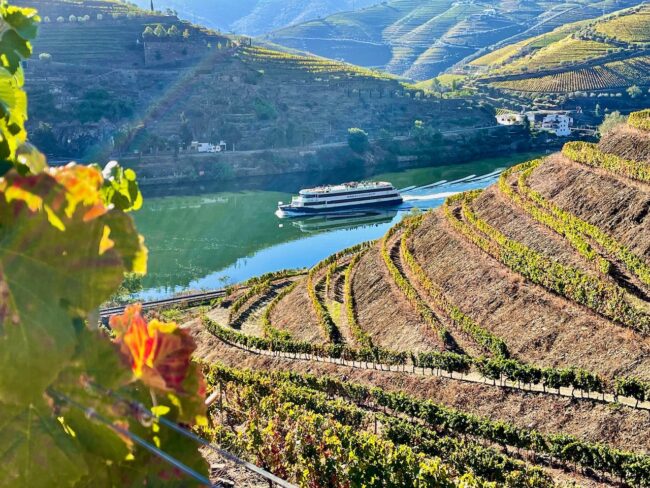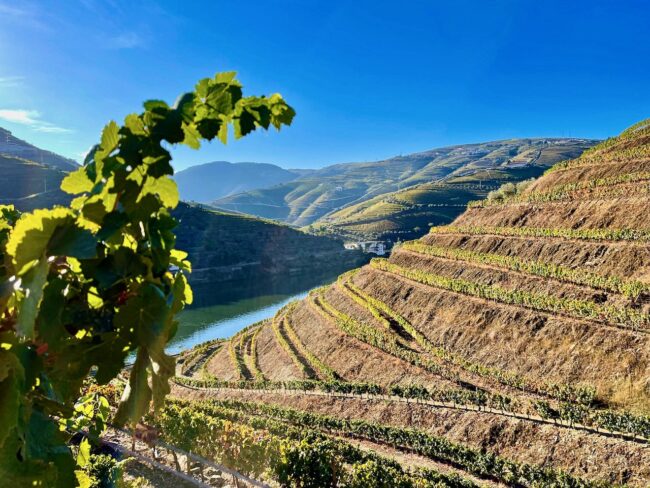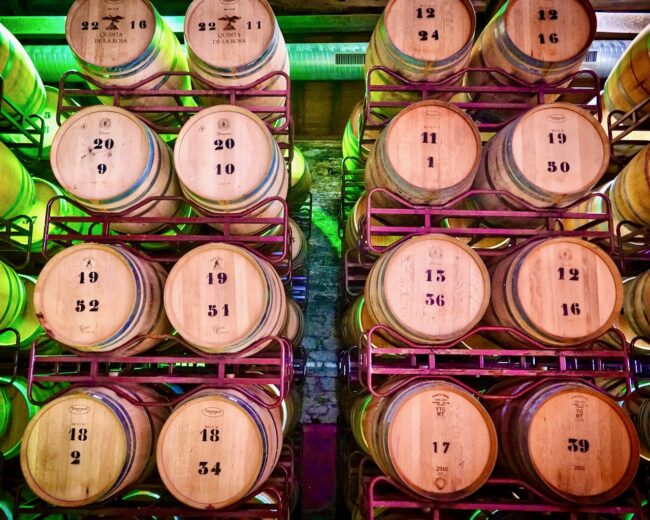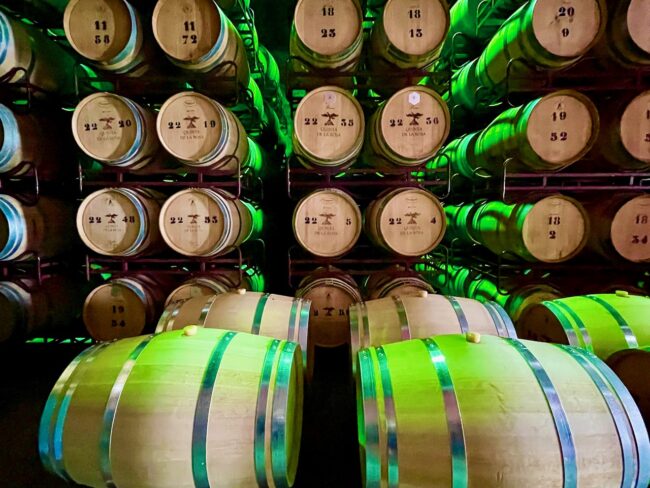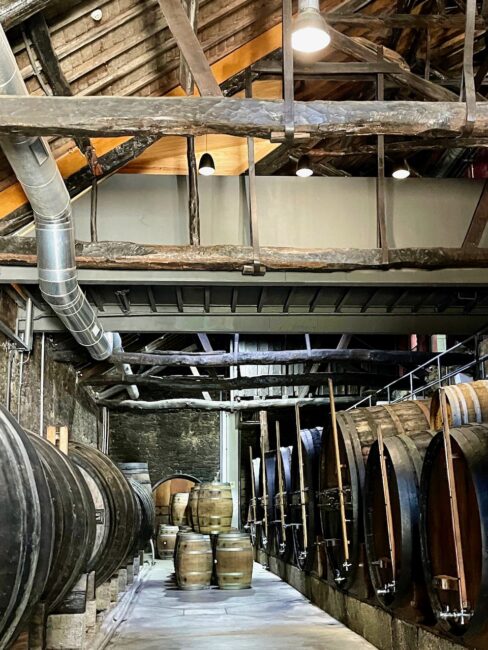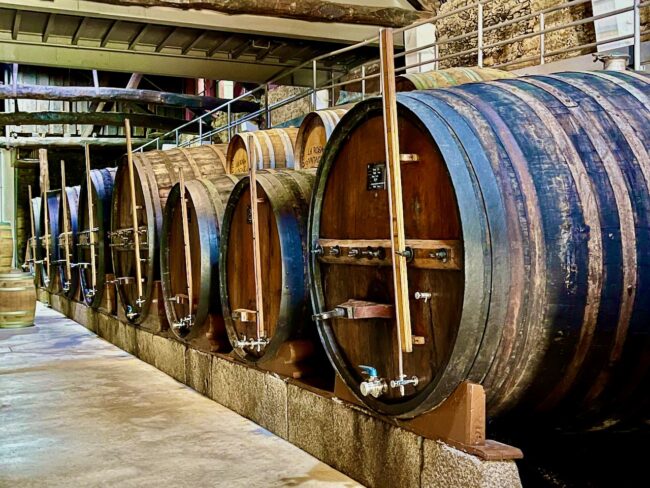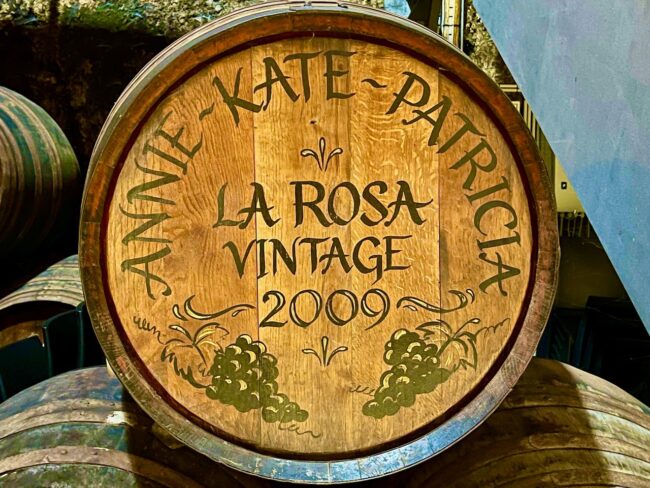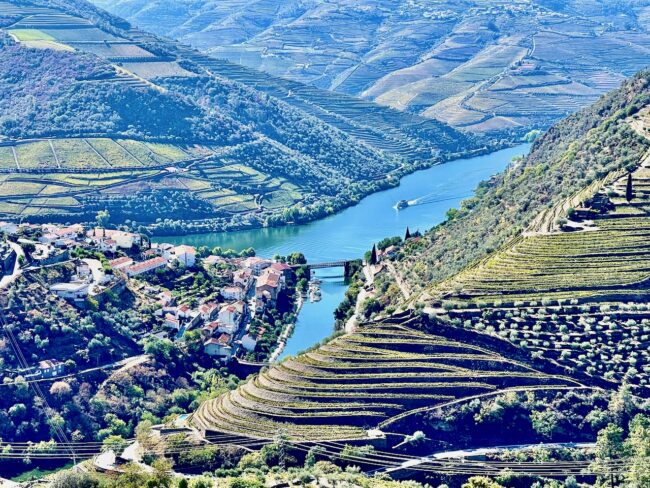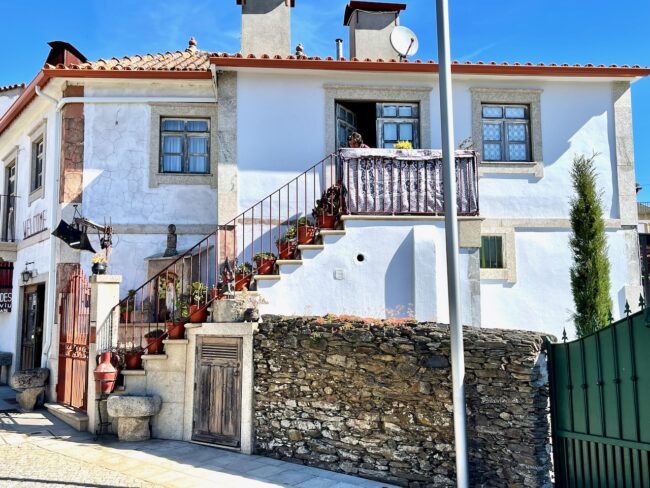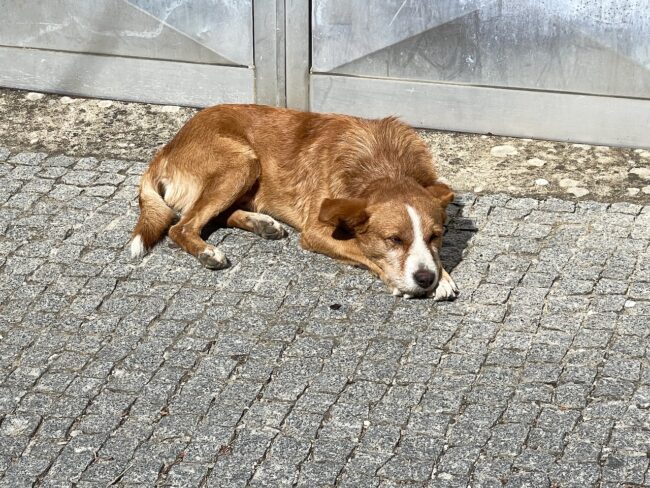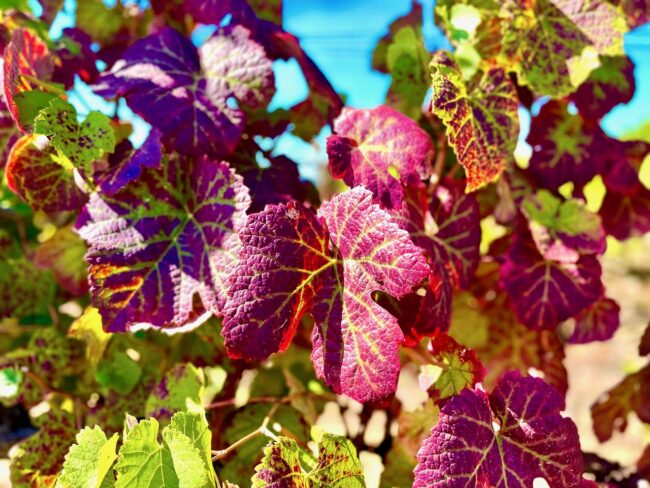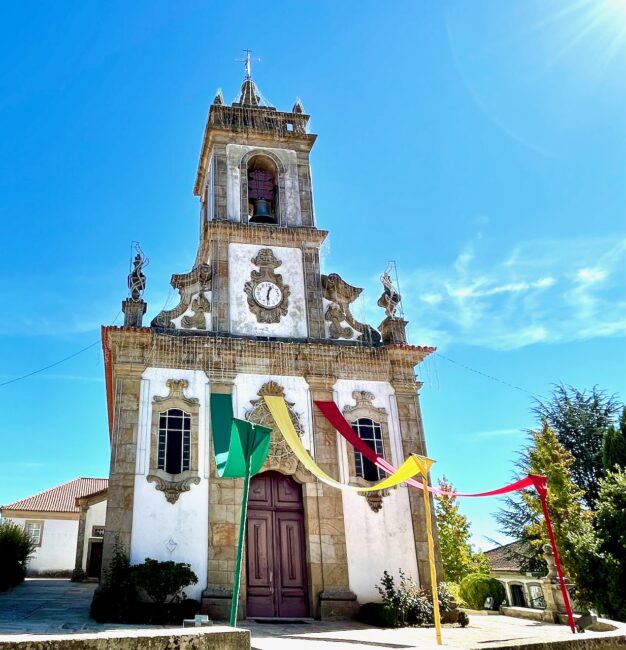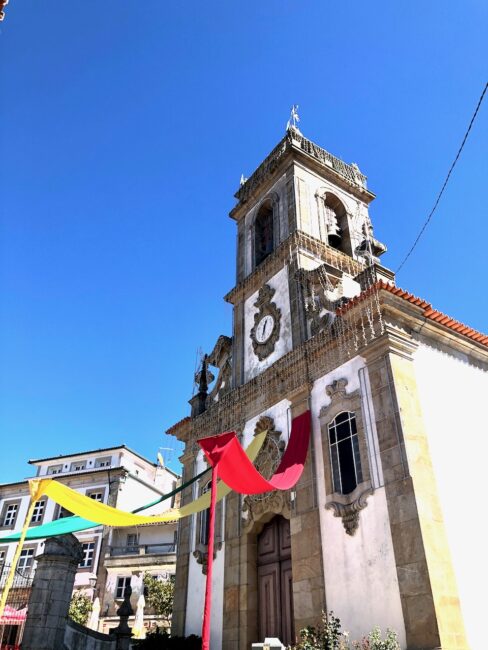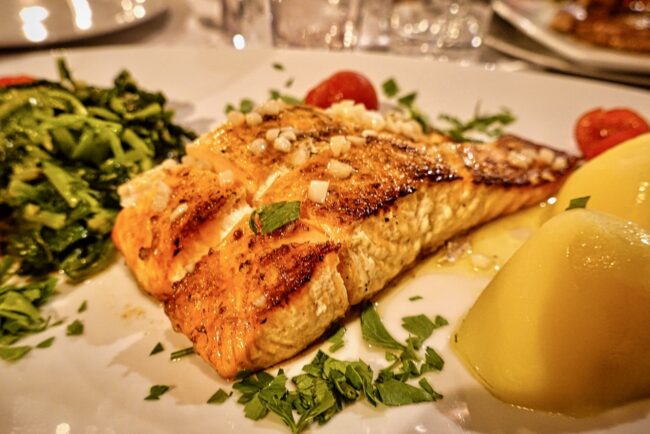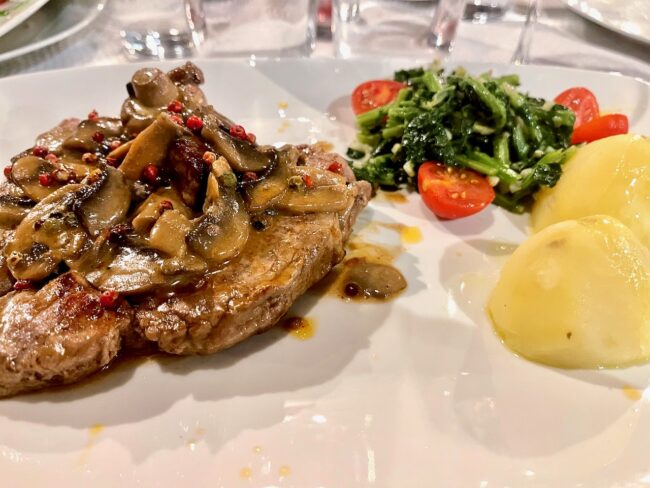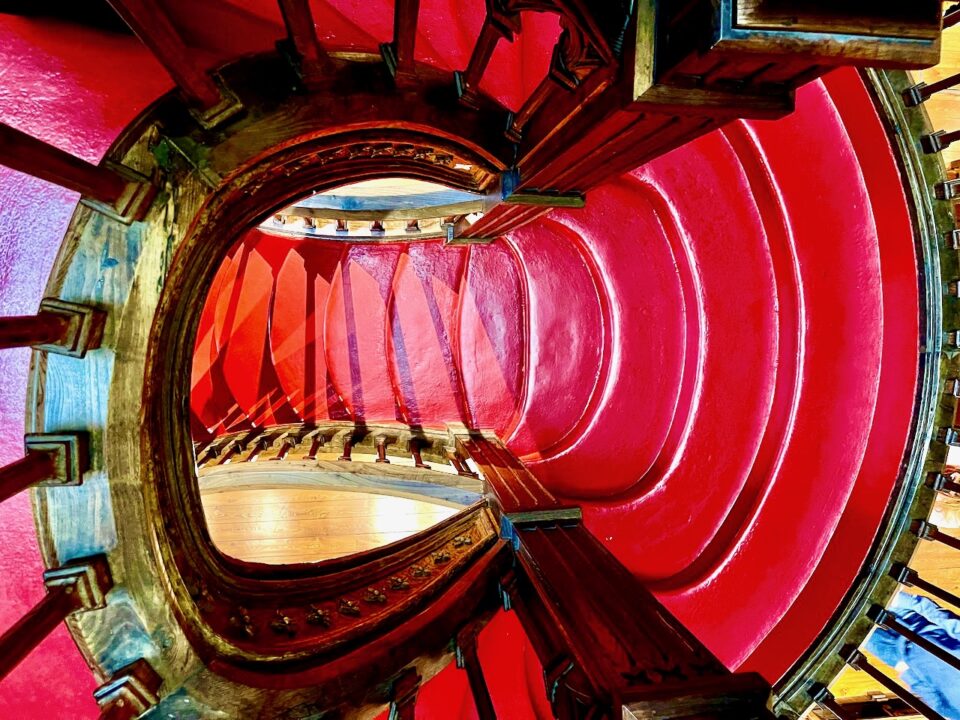
Chapter Thirteen: Combing Coimbra
February 10, 2023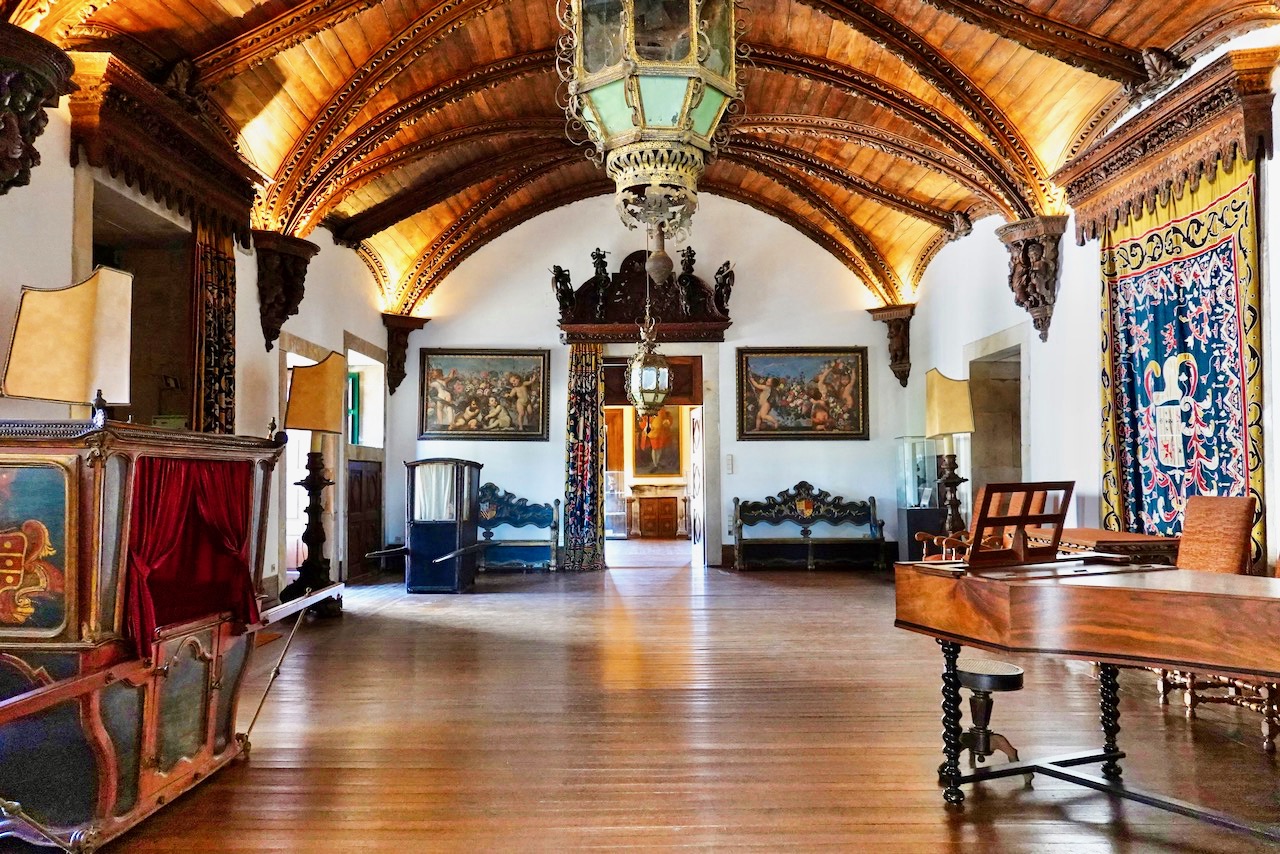
Chapter Fifteen: Rolling On The Douro
March 1, 2023Falling For Portugal: A Mai Tai Tom “Trip” Report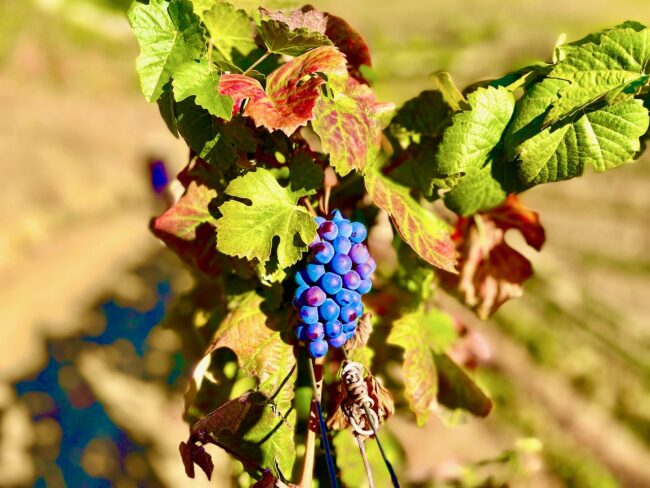
Chapter Fourteen: Viseu, Lamego & On To The Douro
Day Fourteen: A Stop In A Medieval City, Is That An Orange Julius?, Stairway To Heaven, Into The Forest I Go, Yet Another Karen Valentine Highway, “Best Drive In The World?”, Wrong Turn, Bus Stop, Maybe We Won’t Cross That Bridge When We Come To It and A Room With A View
After another delicious filling breakfast at Solar Antigo Luxury Coimbra, we collected our rental mobile from the parking garage and were back on the road with our destination being the wine country of the Douro Valley. About an hour north of Coimbra, we made our first stop in the medieval city of Viseu. We parked near a World War I Monument …
… and walked along some of Viseu’s picturesque streets.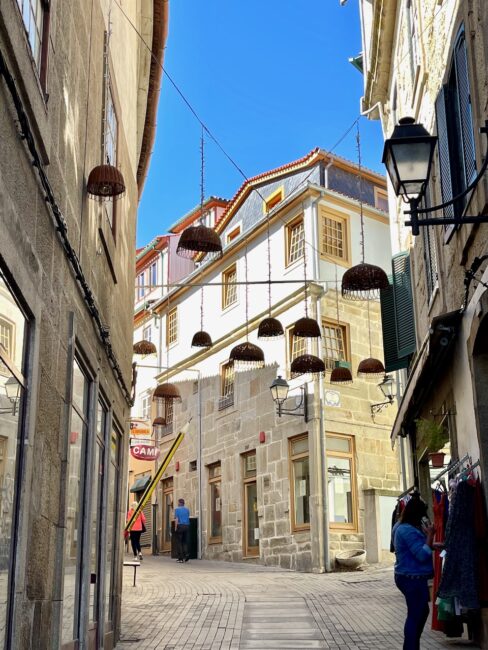
The street lamps hanging over the narrow streets added a unique touch, and this town, filled with charming squares, seemed to warrant much more time than we had allotted. Next time.
Reaching the heart of town, two churches faced one another. Although one had a much more magnificent façade, we chose the Catedral de Viseu (r) located cross the square from the Igreja da Misericórdia (which I would duck into for a couple of moments after exploring the cathedral).
Before entering we took a look at the imposing statue of King Duarte located nearby.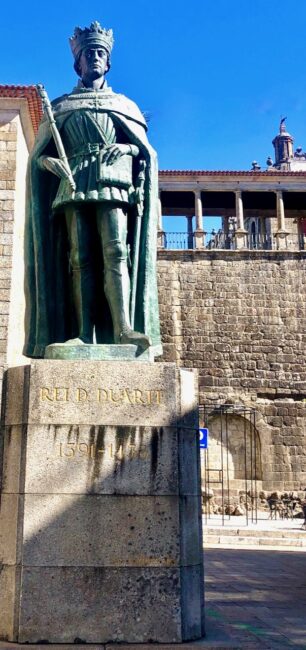
The cathedral dates to the 12th and 13th centuries and was enlarged in the 16th century. 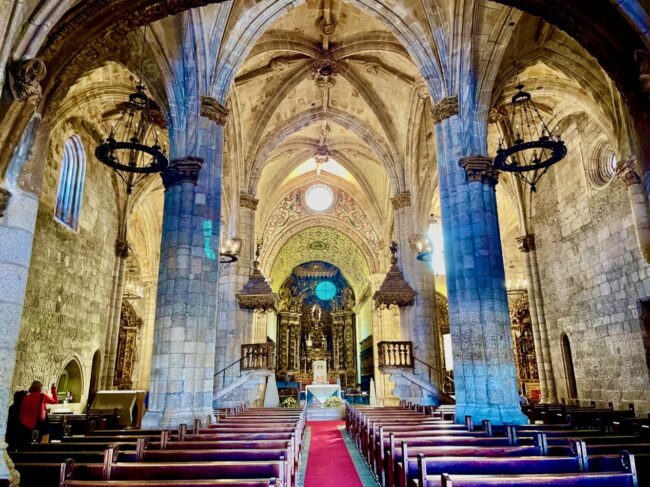
The stone pillars stood out.. There also seemed to be a blue UFO in the altar (either that, or something with the Iphone)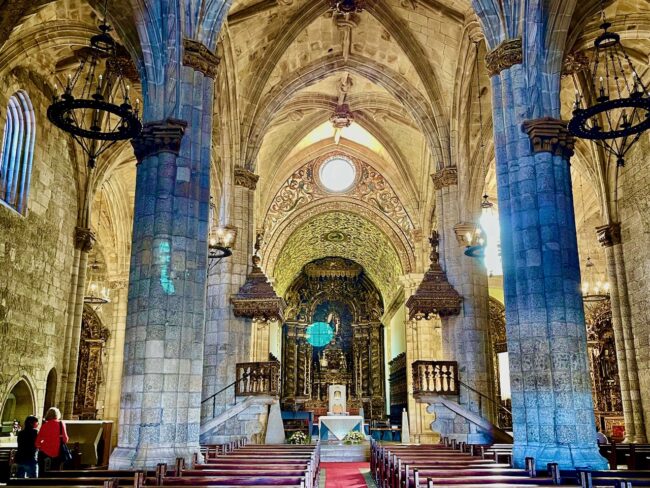
Upstairs there was a better view of the interior (with no UFO) and we also took a look at the choir.
Fortunately for Tracy the ceiling was interesting …
… so she could work out a few kinks in her neck.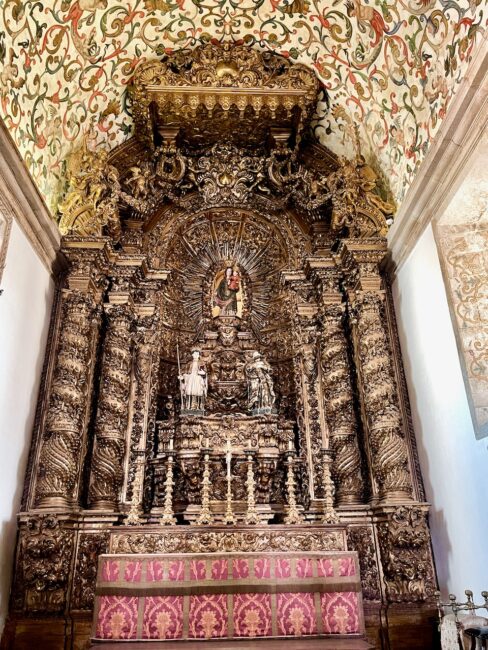
The sacristy doesn’t have a whole lot to see, especially after seeing so much in (some may say too many) other cathedrals. However, we did catch a great view of the Igreja da Misericórdia, along with one of the cathedral’s bell towers.
We didn’t spend an over abundance of time in Viseu, because we had one more stop along the way to the Douro Valley. Still, it was a worthwhile stop.
Before leaving, I took a peek inside the Rococo-styled Igreja da Misericórdia, built in the latter half of the 18th century. I particularly liked the cool balcony below the organ.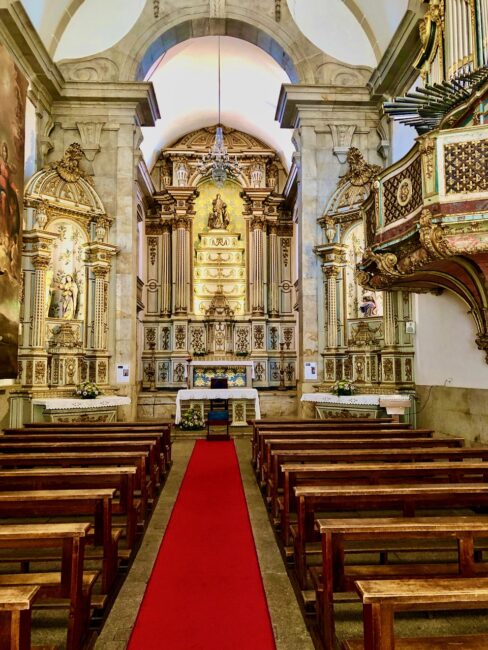
It was about 45 minutes to Lamego. I found driving in Portugal to be very easy. We did have to keep an eye out for Via Verde lanes on the highways, where the transponder in the car would give a little ding to pay whatever toll was at that designated spot. In nine days of driving, despite a lot of dinging, the tolls added up to less than 15 euro.
In Lamego, after parking in yet another stadium parking lot, we searched along a tree-lined street for a quick lunch. We decided on the Com Unhas e Dentes Hamburgueria as it had a 4.9 rating on Google Eats. Tasty burgers and I had a tremendous fresh squeezed orange juice which tasted just like the Orange Julius of my childhood.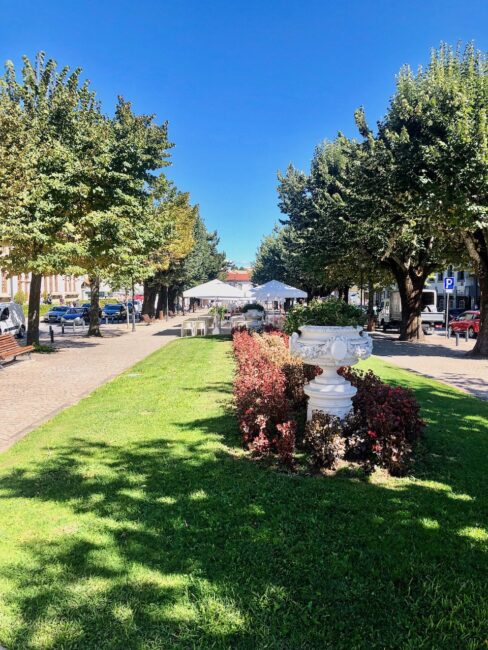
After lunch, my goal was to locate the Santuário de Nossa Senhora dos Remédios, with its set of 686 zigzagging stairs, and I started looking up where to find it. Tracy laughed, “That shouldn’t be too difficult. Look behind you and up.” We had parked virtually at the bottom of the stairway of Our Lady of Remedies, although there was no remedy for my lack of observation.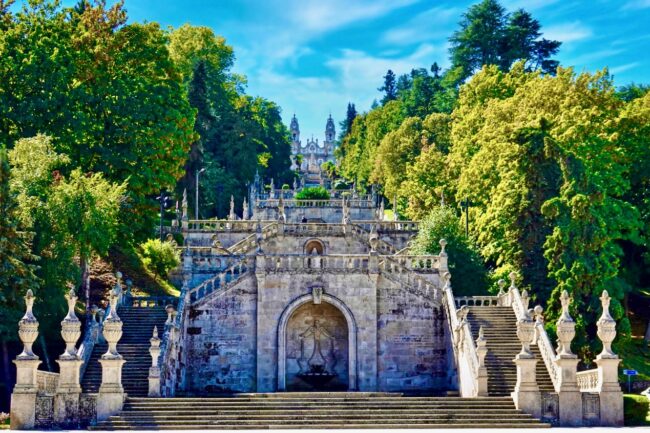
In the old days, I would have eagerly climbed the Baroque staircase to Monte de Santo Estêvão (St. Stephen) where the sanctuary is located. Sadly, my “1,000 stairs a day” vacation mantra has faded into distant memory although after getting close up on top, I think it would not have been overly difficult). I had read that there was a pretty drive up to the church, which is what we did. A winding road through a forest area with camping and picnic sites ended in the parking lot, where we first saw a 700-year-old spreading chestnut tree, although I saw no village smithy standing, and it was more wide than a Longfellow.
We parked (free) and walked around to the front of the church. The current sanctuary was started in 1750 and completed at the beginning of the 20th century.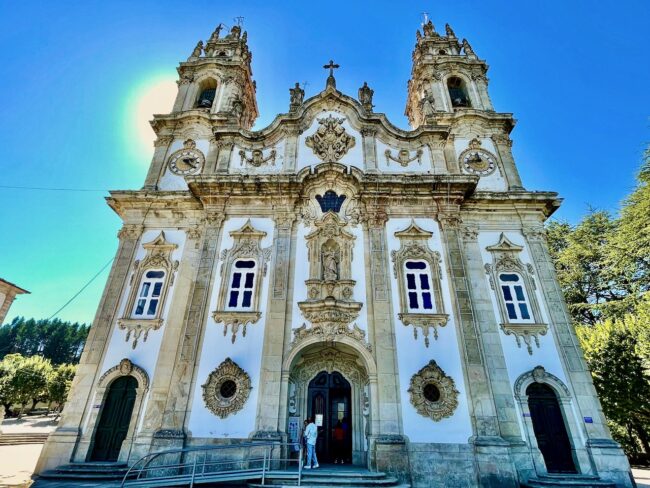
Taking the stairs down a level or two, the views back to Lamego were stupendous.
As we stood on one of the landings, an air raid siren started blaring, and I mean blaring. This went on for a matter of minutes, which was cause for, perhaps, a little alarm, although the thought of Lamego being attacked was certainly remote. Finally, after about about 10 minutes it stopped. Someone we talked with said it was for the volunteer fire department.
On one of the landings was a fountain/obelisk.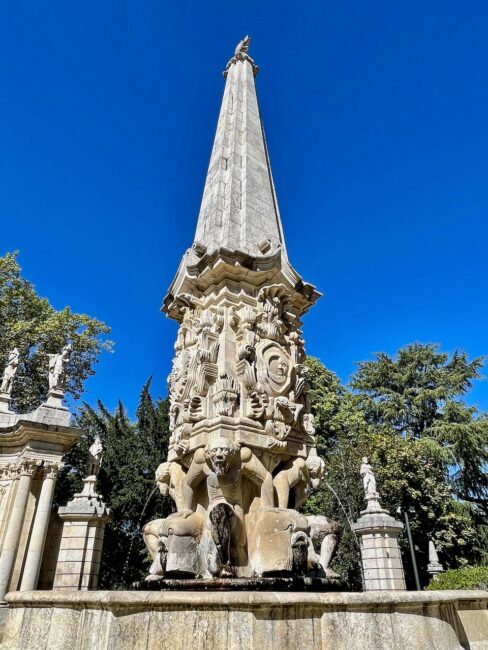
Numerous statues, some of kings, lined the stairways and landings.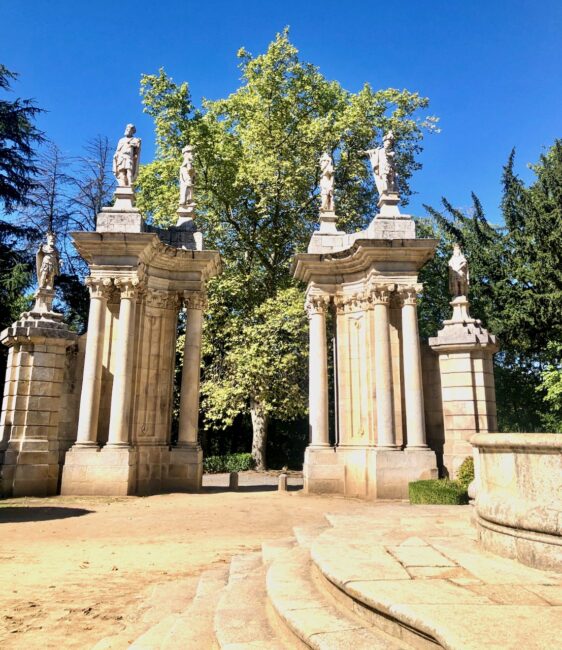
The nine landings are decorated with spectacular azulejo friezes.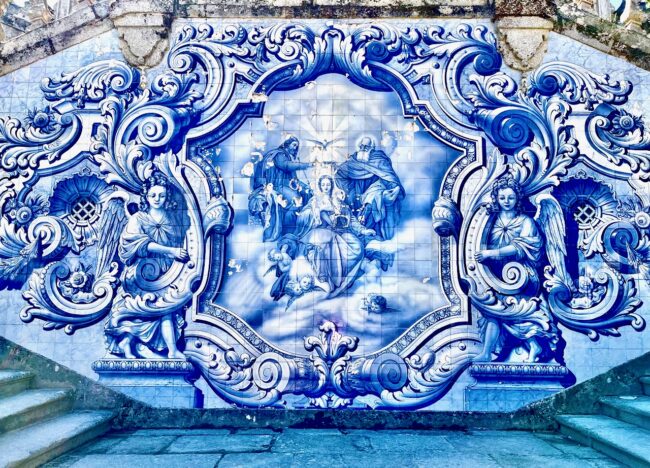
It was mid-afternoon by now, and we wanted to catch a glimpse of the church before hitting the Douro.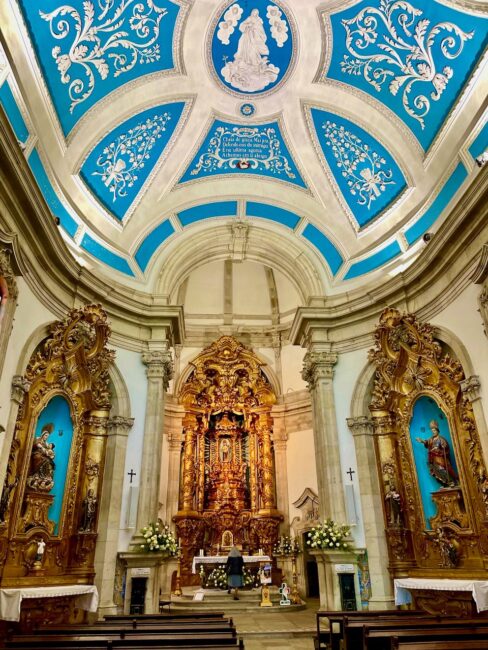
After taking a couple of photos, we learned that no photos are allowed. Sorry.
Apologizing at the tomb of the founder of the sanctuary, Canon Jose Teixeira Pinto, at the entrance to the nave (oops, one last photo), we departed.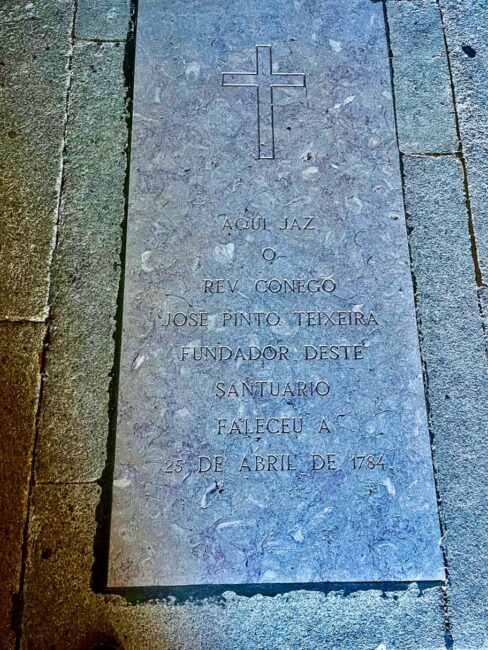
And it was just in time, because a tour bus had pulled up, and the quiet sanctuary we had just enjoyed in relative solitude would soon be overrun.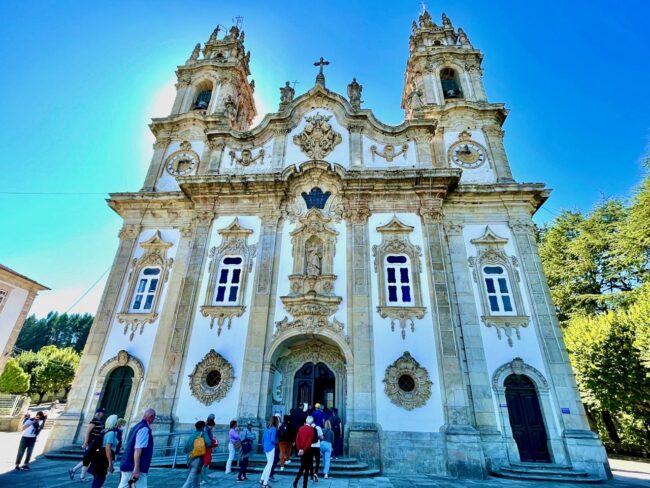
In less than thirty minutes, we were near Peso da Régua, and found ourselves traveling on the Estrada Nacional 222 (N222), which we, of course, dubbed the Karen Valentine Highway (named in honor of the Room 222 star). We had not been on a Karen Valentine Highway since 2005, when we drove on the S222 in Italy.
The road, which runs from Peso de Regua to Pinhão has been awarded the prestigious honor of “Best Drive In The World.” It is undoubtetly lovely, but I would have to say “Best Drive In The World” might be overstating it a bit. Sadly, some portions of the river looked more like a stream as Portugal had been enduring a drought (as Californians, we felt their pain).
It didn’t help that when the road veered slightly to the left, the driver (that would be moi) continued straight. My passengers were quite surprised when I headed straight, and the next words I heard were, “Tom, you idiot, you’re not on the road.” Yes, I was actually now on a driveway of one of the hotels or vineyards that dot the Douro landscape. I quickly reversed and continued toward our lodging for the next two nights, the Quinta de la Rosa. But first we had to get through Pinhão. Approaching the bridge into town, there was a backup of vehicles as two tour busses headed in opposite directions met at the beginning of the narrow bridge. As we eventually learned, it was narrow for two cars to pass each other on this bridge, and impossible for two busses to navigate.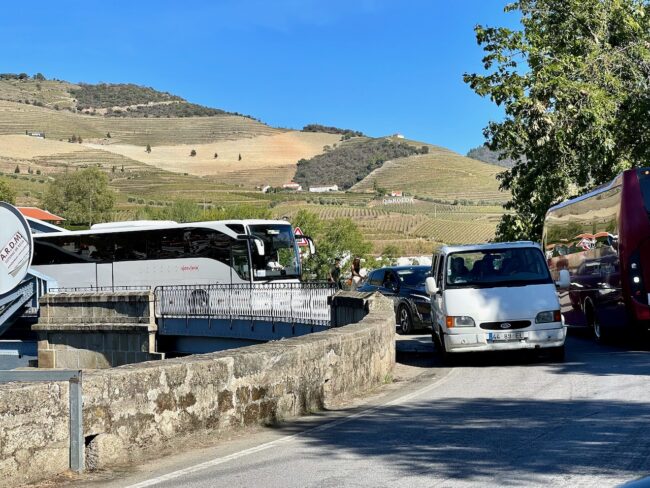
At first it was a wild west standoff, but finally the tour bus entering the bridge reluctantly backed up ever so carefully.
Two kilometers later we arrived at the Quinta de la Rosa, a hotel that doubles as a winery (or vice versa). The reception area featured a floor to ceiling window overlooking the river and countryside. I believe Kim was pondering if it was time to take away my driver’s license. Watch out old man!
Our spacious rooms were great …
…with views of the river and hillside vineyards.
There were some great views from different areas of Quinta de la Rosa.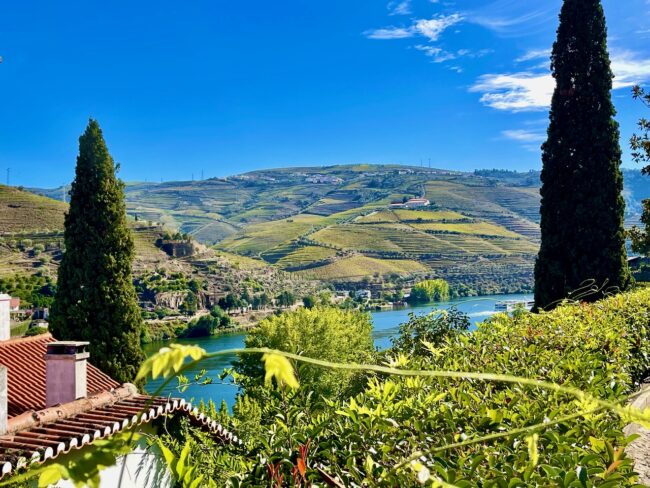
Hoping to help the local economy, we purchased a bottle of wine to enjoy and we headed to dinner at the on-site restaurant Cozinha da Clara, where we dined on the patio.
Although the Maître d’ was pretty grumpy, our helpful and cheerful sommelier/wine server made up for the former’s lack of personality. We started with house-made bread with three different types of butter (chorizo, parsley and olive). The first two were delicious, and the other three assured me the olive was good. Not being an olive aficionado, I will have to take their word for it.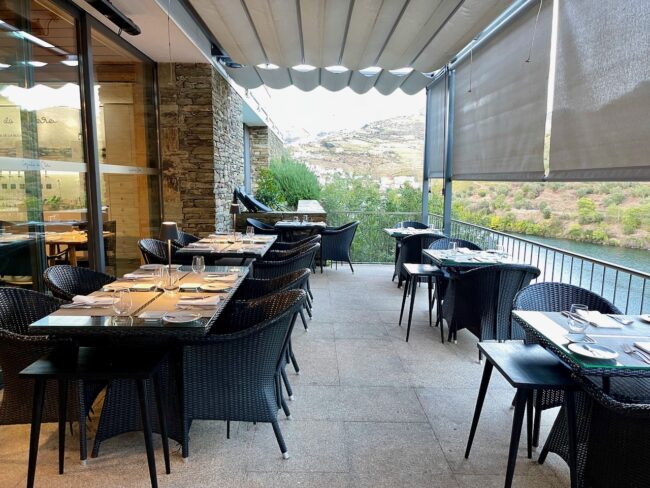
Some of the more interesting dishes consisted of special fried sardines; and confit chicken with potato terrine and roasted veggies.
Tracy and I both started with a fantastic cold pumpkin and carrot soup with ginger and chutney.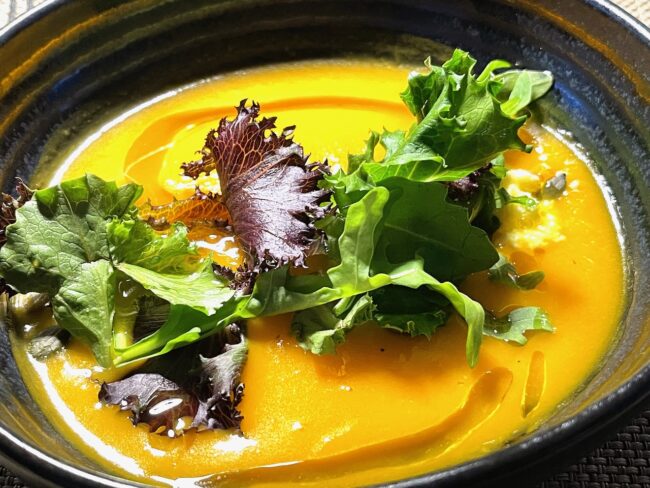
Kim ordered Iberian black pork with what the menu declared was “the most exquisite creamy, truffled mashed potatoes.”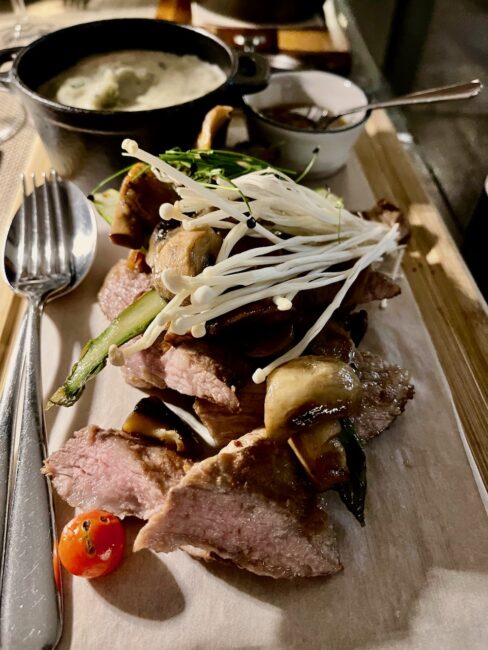
Dinner was very, very good, and the setting was exquisite. Even the Maître d’ had lightened up by the end of the meal. Life is good.
We settled into our cozy room for a good night’s sleep, because we had to get up early for breakfast before our 90-minute tour of one of Quinta de la Rosa’s terraced vineyards and its winery. Then we would head for the hills to check out a few of the small towns surrounding the area. Dinner would be in Pinhão at another restaurant with a patio overlooking the river.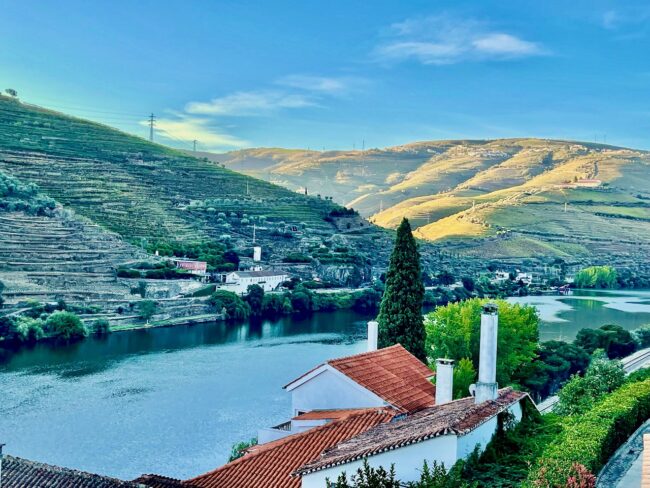
Day Fifteen: That’s Not What It Looks Like, Take A Hike, Not Dante’s Inferno, Changing Colors, A Barrel Of Laughs, Kids In A Vat, Send In Trevor Hoffman, Where Is Everybody?, Spectacular Views, Wrong House, We’re Walking Here, A Smoke Filled Room, “Two Guys With Attitude” and No Lamb For Ewe
Today was one of those mixed bag vacation days that doesn’t go quite the way you planned. It did get off to a good start. After a quick bite at the hotel restaurant buffet (included with the room), we arrived at the Reception area to await our guide. Although this picture looks suspiciously like Kim and I are peeing on the window, trust me we weren’t (or at least I wasn’t).
At 9 a.m. sharp our guide Isabel (not the one from Sintra) appeared and we headed out to the Vale do Inferno. It was a clear, crisp morning, but it would give way to very hot conditions later. I was glad to have chosen the early tour.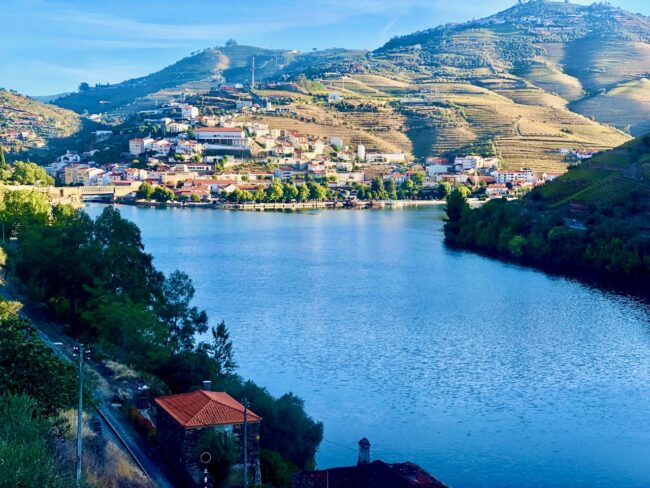
We strolled along the property first.
I was sure Sintra Isabel had called Douro Isabel, when the latter warned, “Do not even attempt these steps.”
We “pressed” on.
Walking along a dirt road we entered the Vale do Inferno, which has no correlation to Dante’s book. The terrace vines were awash with autumn colors …
… but it looked like one misstep could have a laborer (or unbalanced tourist) tumbling down the hillside. We safely ambled on.
The crush had been completed just a few days before we arrived but a few grapes still clung to the vines.
Quinta de la Rosa has 60 acres of vines in the Douro Valley, and they also have a property near the border with Spain. Although the family acquired the property in 1825, the winery wasn’t started until much later by the family matriarch, Claire, “who was gifted the estate and vineyard for her baptism in 1906 and lived in the house for much of her life.” One of her children, Sophia, is the estate owner and manager today.
The views were remarkable, and Isabel was very informative sharing the storied history of the winery and the family. Built during the first world war, these are some of the highest-terraced vineyards in the Douro.
Back at the hotel property, we checked out the guest swimming pool.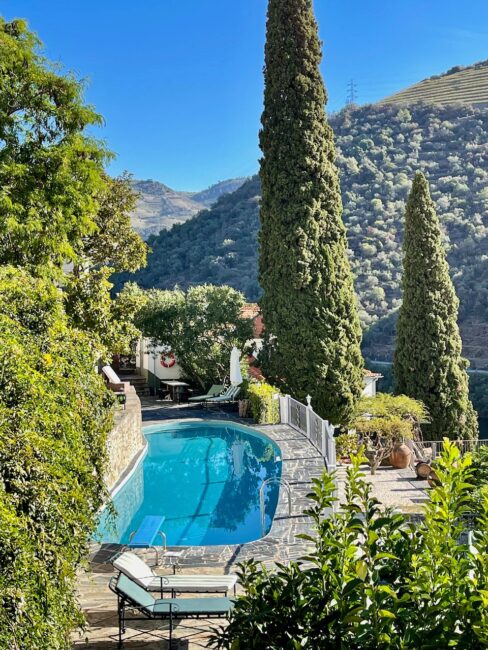
Isabel took us into the wine cellar where the grapes were fermenting.
She told us that the winery was able to start producing port in 1988, when Sophia and her father Tim relaunched Quinta de la Rosa and started to make Port wines under their own label.
Unbeknownst to me previously, we learned that only port made in the Douro region of Portugal can be called port (like champagne is supposed to come only from the Champagne region of France in order to be called champagne). In 1996, Quinta de la La Rosa was awarded the Fortified Wine Maker of the Year at London’s International Wine Show.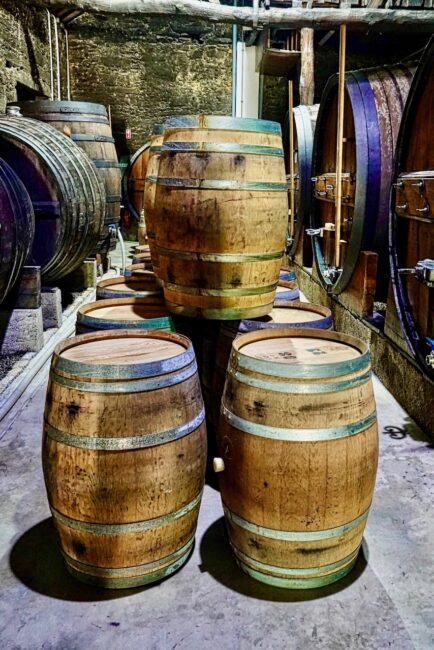
Special casks are marked with the names of children in the family and the year they were born. When they turn 21, a big party is held where the cask is opened to sample the port. Three were born in 2009. Maybe they’ll invite me.
Speaking of casks, we were asked what the little door on this one was for. Tracy jokingly replied, “That’s where you put the kids when they’re bad.” She was actually pretty close. Isabel told us the small door was indeed for small children, who decades earlier had been used to clean the inside of the cask. She assured us this was a tradition that has since been discontinued.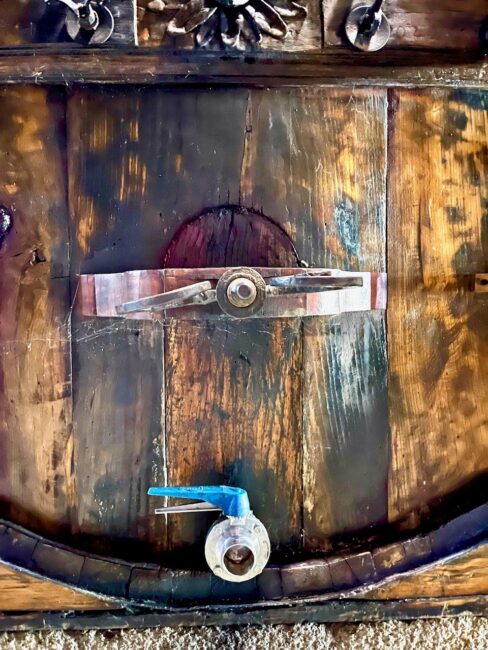
Our tour (€30) completed, we decided to head for the hills and explore some of the nearby hill towns. Unfortunately, I had parked in a way that made it difficult to actually turn the car around so we could get on the road without backing onto it. When the driving gets tough, the tough call on Kim to be the relief driver (the automotive version on Trevor Hoffman). I had not called on Kim since the episode in Spain where he extracted us from a parking conundrum with a walnut tree that was watched with great humor by the locals, who actually applauded Kim’s driving skills when he managed to extract the car without a dent in either the car or the tree.
Safely turned around, I re-entered the cockpit and we drove into the hills, stopping to admire the scenery at this viewpoint.
Our first stop was Provesende, where I had heard about an 80-year-old bakery, Padaira Fatima. Parking on the edge of town, we walked into town.
The one thing that seemed to be missing were the people. For ten minutes the only thing we saw was a dog who looked like he needed some human companionship. The leaves were pretty, too.
We finally found a person and asked about the bakery, but she said it was closed, which was not what I kneaded to hear.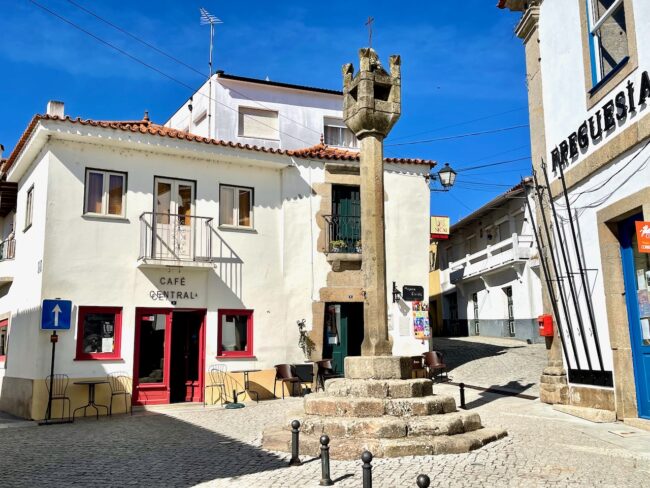
I was able to find (by luck, since there weren’t really many people to ask) the Fountain of Provesende, built in 1755.
Our next stop was Sabrosa, the birthplace of Fernão de Magalhães (Magellan), the first person to circumnavigate the world. Again the town was virtually empty, and I started to think we were in an old Twilight Zone episode. We ducked into what looked like the Igreja Matriz de Sabrosa, but when I did …
… all I saw was this small chapel. I looked around for Rod Serling.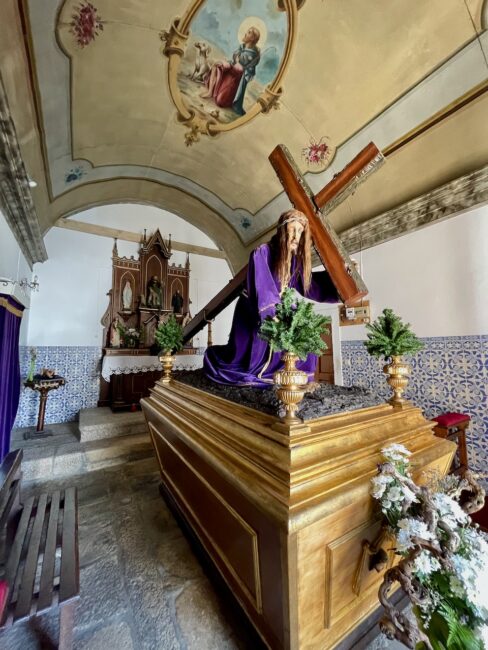
I was excited to explore Magellan’s birthplace, only to learn when I returned home was that it was just a building on Rua Fernão de Magalhães. I couldn’t even circumnavigate Sabrosa, but at least I didn’t get killed by a poison arrow.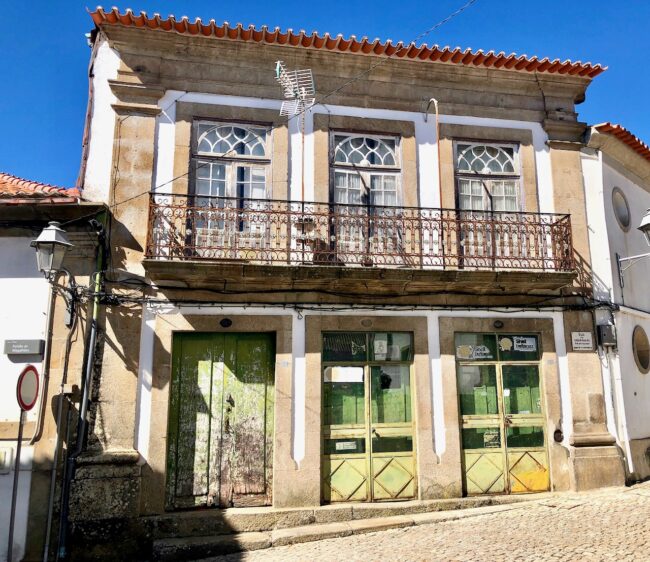
Back in the car, we thought surely there would be a decent spot for lunch in Favaios. It was a pretty drive.
In Favaios, I did something I had not done since our infamous 2005 Italy trip (no, not put the wrong petrol in the car). It was tough finding a parking place, but I assured the group, “There’s one up ahead. I’ll park there.” Then, for the second time in as many days, as I pulled up to where I thought we could park, I heard Tracy mutter the familiar driving words of endearment, “Tom, you idiot.”
I said, “What did I do this time?” She replied, “You are driving on a pedestrian plaza.” Yes, citizens of Trevi, you are now not alone.
We walked through town, as I shielded my face from the local citizenry. Passing by the Bread & Wine Museum, I asked Kim and Mary if they wanted to go in. Kim replied, “I prefer not to spend the dough.” Thankfully, only one week was left on our trip.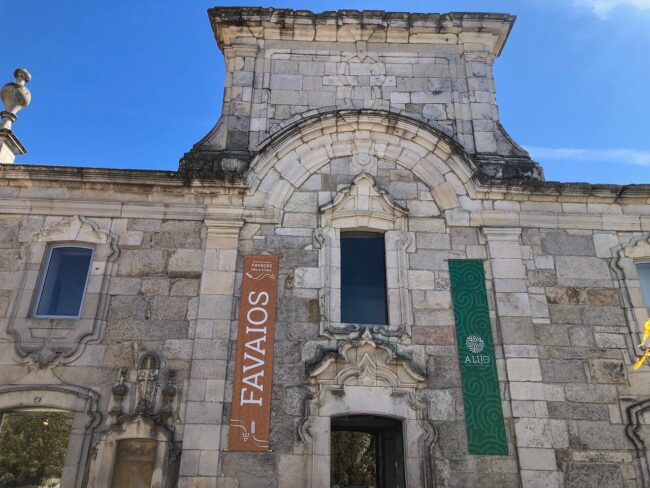
Kim checked the Meal-o-Meter on his phone, and said there was a good restaurant not too far away we could try. I don’t know what “not too far away” meant to him at that time, on a day that was approaching 90 degrees (32.2C), the hike alongside the vineyards was taking quite some time. Kim had recently recovered from cancer treatment, and he was leaving us in the dust. Show off!
We happened upon an old woman who looked very much like Ed Asner’s animated character in the movie “Up,” who looks just like Spencer Tracy. But I digress… When we asked her about the restaurant Kim and Mary were headed to, she shook her head, pointed in the opposite direction, and said, “Better restaurant.” Narrowly averting heatstroke, as we walked up a steep cobblestone street the woman had told us not to go to, we caught up with Kim and Mary only to learn the restaurant was full with people waiting (so this is where they all are?). We trudged back down the hill to town.
It was now the dreaded no lunch zone of 2:15, but Kim and Mary bravely entered a smoke-filled den (café) where Mary purchased coffee and pastries. Meanwhile, we sat in the shade and entertained ourselves by watching a woman feed a dog on the plaza, where I had parked about 45 minutes previously. I donned my sunglasses in case anyone recognized me.
Tracy loves to taste olive oil, and I had read about a place not too far away, the D’Origem Olive Oil Museum. As we approached on a narrow street a quagmire of cars boxed us in. Tracy and Mary got out of the car and jogged the short distance to inquire where was the best place to park.
A few minutes later they hopped back in the car, and said, “Let’s go.” Kim and I were perplexed. Tracy and Mary explained that the people working there were real jerks, “two guys with attitude,”so no olive oil tasting for us. I had also wanted to go to the Miradouro de Casal de Loivos, which has been said to have “the best view in the world,” but our car was facing the wrong direction with no easy place to turn around. Plus, it was unbelievably hot and it seemed nobody was really in the mood to explore. I get my Miradouro solace by watching Youtube videos. Ah, the best laid plans…
The Val de Mendez was lovely …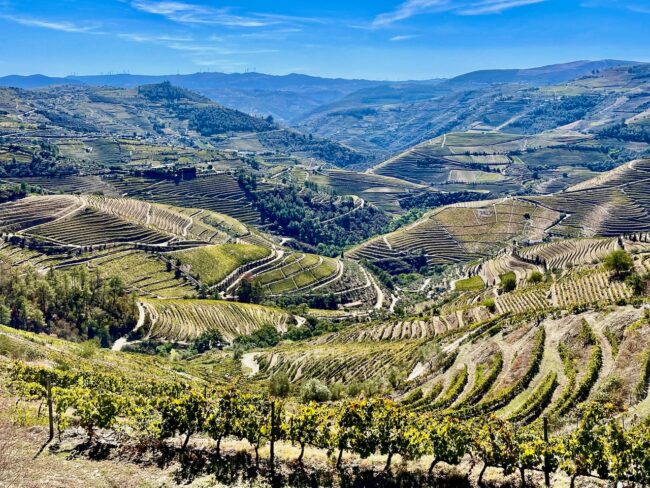
… and shortly we were back along the river.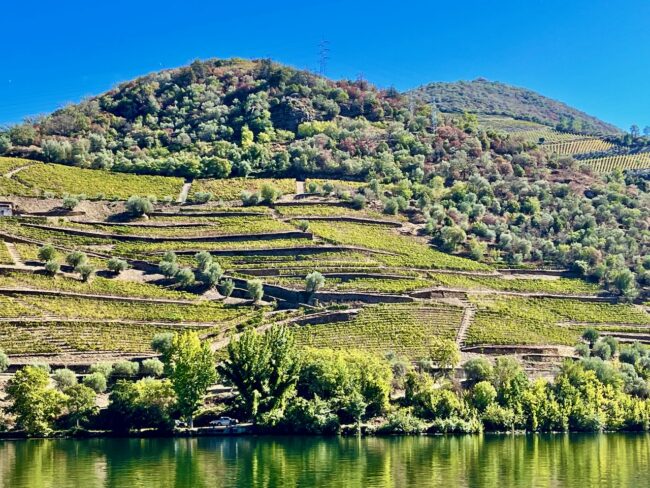
Tracy and I hopped up to Tim’s Terrace, a patio restaurant at the Quinta de la Rosa, and even though dinner was not that far away, we shared a small bite and some vinho. 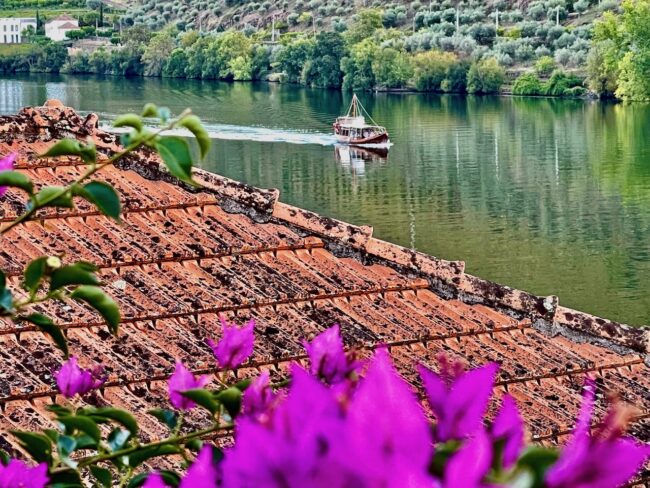 Dinner on this evening would be in Pinhão on the patio of a restaurant called The Writer’s Place. The view from where it is nestled on the curve of the river almost under the bridge was lovely, and the patio was covered with grapes hanging from the arbor. It was all starting well.
Dinner on this evening would be in Pinhão on the patio of a restaurant called The Writer’s Place. The view from where it is nestled on the curve of the river almost under the bridge was lovely, and the patio was covered with grapes hanging from the arbor. It was all starting well.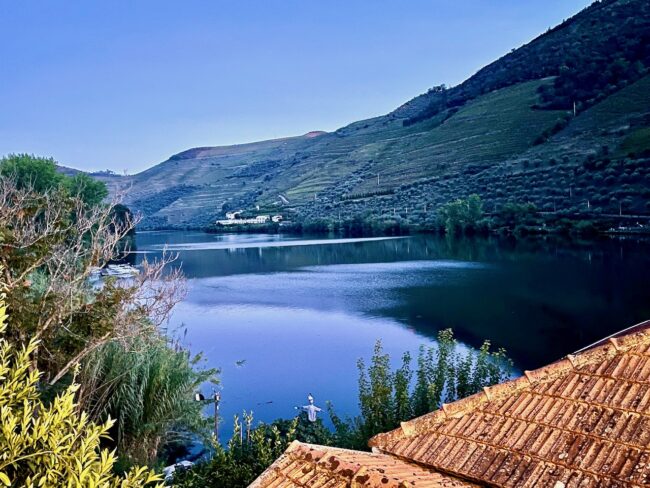
Last to order, I chose the lamb. For the umpteenth time on the trip, and even though the restaurant had opened just scant minutes earlier, our waiter said what sounded like, “None for ewe” but was more likely, “we are out of lamb.” It had happened so many times in the past two weeks, he probably did not know why we were all laughing. I eventually ordered the pork.
Mary loved her fish from the Douro (airy lightly breaded white fish).
Kim’s grilled salmon and Tracy’s pork were also good.
However, my dinner did not arrive. After about ten minutes I asked about my pork, and it seemed they had forgotten my order. My guess is the waiter was new, and just like in the states or in Sintra, mistakes happen. That said, the food was good, and it wasn’t like we were in a hurry. Did I mention the view was splendid indeed?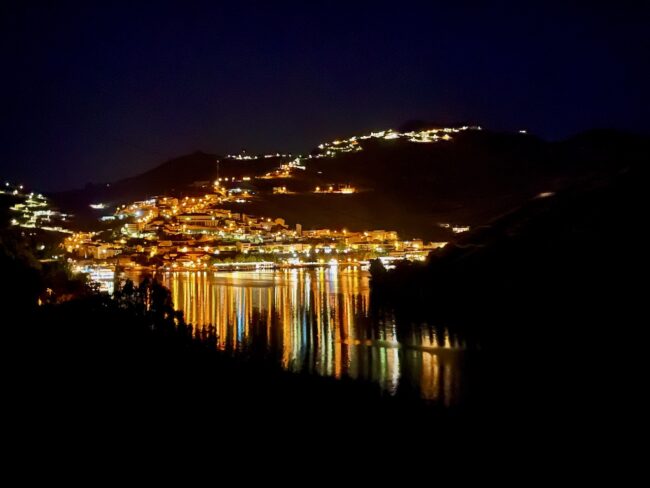
I had thought three nights in the Douro would be optimal, but circumstances worked out that we spent two nights at Quinta de la Rosa and two nights at our lodging the following two days, Quinta do Pego, which is located almost directly across the river. There has always been much discussion on the Fodor’s Travel Board as to which one is the preferred accommodation. Now, we could weigh in with our opinion.
The next morning, our first goal was to make it to our new dwelling. The private road on the Quinta do Pego property is steep and winding and only accommodates one car at a time. My passengers were fearful with my driving skills that they might plunge down the steep vineyard and into the river. To tell you the truth, so did I.
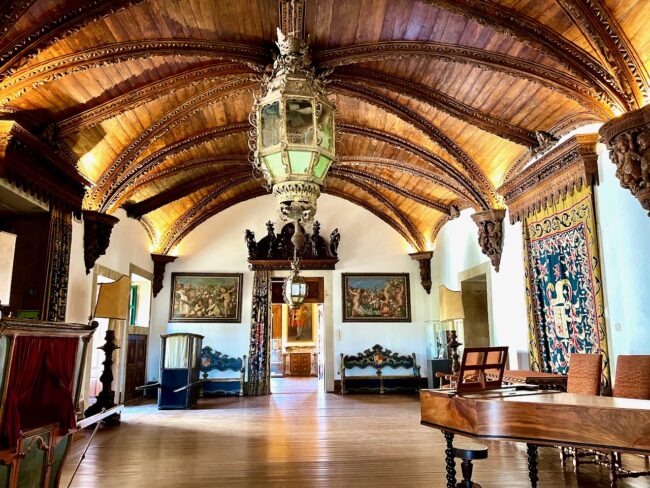 Obviously we made it, because, after checking in, we’d hit the Karen Valentine Highway again back to Peso da Régua, to visit the Museu do Douro to learn about the region’s wine making.
Obviously we made it, because, after checking in, we’d hit the Karen Valentine Highway again back to Peso da Régua, to visit the Museu do Douro to learn about the region’s wine making.
Then we’d head up to to take the tour I had arranged at Casa de Mateus, an 18th century palace with beautiful gardens.
Then it was back to our new hotel to relax on its terraces under the olive trees with magnificent views.
Chapter Fifteen: The Douro – Part Two
Day Sixteen: To Everything Turn Turn Turn, Any Port In A Heatwave, A Wonderful Tour, Glorious Gardens, More Bats?!, Getting Supplies, Down For The Count, This Is The Way To Live, Fiona Can We Adopt You? and An “Appetizing” Dinner

